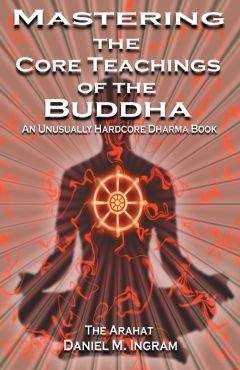Daniel Ingram - Mastering the Core Teachings of Buddha - An Unusually Hardcore Dharma Book
На электронном книжном портале my-library.info можно читать бесплатно книги онлайн без регистрации, в том числе Daniel Ingram - Mastering the Core Teachings of Buddha - An Unusually Hardcore Dharma Book. Жанр: Прочее издательство -, год 2004. В онлайн доступе вы получите полную версию книги с кратким содержанием для ознакомления, сможете читать аннотацию к книге (предисловие), увидеть рецензии тех, кто произведение уже прочитал и их экспертное мнение о прочитанном.
Кроме того, в библиотеке онлайн my-library.info вы найдете много новинок, которые заслуживают вашего внимания.

Daniel Ingram - Mastering the Core Teachings of Buddha - An Unusually Hardcore Dharma Book краткое содержание
Mastering the Core Teachings of Buddha - An Unusually Hardcore Dharma Book читать онлайн бесплатно
Further, if you follow some of their advice but change parts, or select parts and add on other things, and then find that this way of working has not produced the desired results, be careful about criticizing the teacher or the method, as you have not done the experiment they recommended. For instance, if someone told you to stabilize your attention on the individual sensations that make up the experience of breathing so clearly that you can see the beginning and ending of every single sensation consistently for an hour, and instead you do something else or stop the practice before you can do this, don’t blame them if you do not get the results they promised. Barring insurmountable external circumstances, the choice not to do the work was clearly yours, and thus you should accept personal responsibility for 82
Practical Meditation Considerations
your own failure. I am not trying to be harsh but simply realistic. I am obviously a firm believer that people should take responsibility for what happens in their lives and practices. Not doing so is tantamount to disempowering yourself.
While all of this advice on practices and teachers may seem a bit overwhelming, reconnecting with the basics, the simple truths of the spiritual life, is highly recommended. To that end…
83
10.SUMMARY
The more we practice being kind and compassionate, the more we connect with the fundamental nature of our hearts and the better our conventional lives will be.
The more we practice being clear and equanimous, the more we connect with the true nature of our mind and the healthier our minds will be.
The more we practice understanding the Three Characteristics of all the little sensations that make up our reality, the more we penetrate into the fundamental nature of reality and the closer we are to awakening and to freedom from fundamental suffering.
84
11.CONCLUSION TO PART I
People have noticed a decrease in the importance of poetry to our society. It has been said that our desire for more information, faster images and quick sound bites is increasing. We are searching faster and faster, perhaps at the expense of looking more deeply.
Rather than sitting with a Shakespeare sonnet for a few minutes, just pondering the beauty and meaning of it, we might read ten of them quickly and then feel a bit befuddled. Similarly, one might read though a dense little work like this one without stopping to ponder each paragraph along the way and thus perhaps get little out of it. Just so, we may be constantly trying to find the next teacher, book, spiritual scene, technique, incense, mantra, costume, or doctrine that will get us the Big E. Quick results are actually possible, though there are no promises about the speed of progress that can be given. Real progress will only come when we settle into the basics, into this moment, and go deep.
These lists are good sources of the basic teachings that are sufficient to do the trick. Go deeply into them, or find them in another form, perhaps in another tradition, and go deeply into them. Slow down.
Settle into these simple truths, reflect, and then practice with diligence!
Good teachers can help; they are nearly a necessity and so are highly recommended, but you must do the work yourself. You must
understand, and then you will have to do this again and again. Get used to it, as it can be quite an adventure.
It is sometimes hard for people to believe that right there in their experience is what they are looking for. It is right here, right now, in your own experience, in your own heart, mind and body. It is these sensations right now that are just soaked with the truth.
Forgive me, but one more time up on my soapbox. There is so
much completely useless and harmful sectarianism in the spiritual world, within Buddhism and between Buddhism and the other spiritual traditions. People can get so into their particular trip and get all down on the other perfectly good spiritual trips. This is faith out of balance causing rigid adherence to dogma, isn't it? This is a lack of understanding of what the basics are and what are just the inevitable cultural trappings and individual emphases of each tradition.
85
Conclusion to Part I
These are the basics. Wherever you find a tradition with the components of even one of these lists, regardless of what they are called or how they are formulated, you find a tradition with the potential to awaken. Sure, there is a lot of junk spirituality out there, but there is also a lot of really good stuff.
Again, each tradition has its strengths and weaknesses, and some may have cultural trappings and ornamentation that you like or don't like, but don’t make a big deal about this.
Instead, keep the basics in the front of your mind. Each valid tradition can help us gain further insight into the truth, and perhaps we will resonate with one teaching or tradition at one time and another some time later. Alternately, we can pick one tradition, not be sectarian about it, and go deep into it, into the simplicity and clarity of its basics, using its extrapolations, elaborations and interpretations to go back more deeply into the simple truths. We can engage with the ordinary world, with the truth of this moment, and this will empower us and may awaken us.
May this writing be of benefit to you and all beings, and may you and all beings realize the simple truth of things in this lifetime.
86
PART II: LIGHT AND SHADOWS
87
12.INTRODUCTION TO PARTS II & III
Some chapters in Parts II and III have a distinctly cutting tone. This is intentional, though no harm is meant by it. There are a lot of shadow sides to Buddhism and mystical traditions in general, some of which will be discussed here. Perhaps a more cutting tone will help to illuminate points that tend to be unmentioned or poorly addressed. Perhaps it will also serve to spark skillful debate and inquiry, rather than causing needless contraction into fear and dogma. However, I should warn you now, some of the next three chapters have quite a bite to them. There is no information in those chapters that is essential to any of the basic practices. If you are not in the mood for some really heavy and scathing social commentary on Western Buddhism, please, skip to the chapter called A Clear Goal now!
The practical reason for including Part II at all is that what often happens between trying to apply the basics of technical meditation discussed in Part I and the successful entry into real meditation territory discussed in Part III is that we run into the mainstream culture of Western Buddhism and the communities that develop around it. We need support, friends who are into what we are into, good teachers and places to practice. We wish to be in the company of fellow adventurers rather than lone wanderers in strange lands. Unfortunately, much of what we find is not particularly conducive to adventure and deep exploration at all.
Thus, as one small dissenting voice against the tide, I have included Part II to help those who want to go much deeper than most of those around them and avoid the numerous cultural sidetracks and
disempowering voices that will keep them from their goals. It is as much a laundry list of my pet peeves as it is anything else, but I am happy to own my neuroses and make them overt. While I may be fooling myself, I think this section, while a bit harsh and probably disrespectful, is likely to be helpful to someone who also wishes to go against the grain and become an actual meditation master.
The real dangers that come from using a cutting tone are that it will alienate both readers for whom such a tone is simply not helpful and those who could really benefit from such a tone but do not want to admit this. Worse, it may cause others to agree too strongly, thinking,
Introduction to Parts II & III
“Oh, yes, even though that Daniel fellow sometimes writes like a raving lunatic, he and I are really on the same side. We know what is going on.
Those over there are the ones who really need to hear this.”
We all need to hear the points made in this book, myself included, though not necessarily in the style presented here. The ideals and standards presented in this book are very high so that they will be able to be applied universally. Further, the numerous traps and pitfalls presented in this book are also so common that all of us need to be wary, reflecting regularly and honestly on how we have fallen into them once more.
There are quite a number of very readable, helpful and friendly dharma books out there, e.g. Jack Kornfield’s encyclopedic masterwork, A Path with Heart, many of which are loaded with brilliant statements that should basically shock and confound the reader, hitting at the very core of their sense of identity with the deadly accuracy of a Master of Zen Archery. However, as they have been written in a style that is so completely accessible, these statements have nearly the opposite effect, creating a mushy comfort in the reader with statements that should have stopped them in their proverbial tracks and provoked deep inquiry.
I have grown tired of people routinely quoting profound dharma statements from such works as if this represents their understanding when they have no idea what they mean. They seem to derive some false comfort from being able to parrot the masters. While I can understand the appeal of behaving in such ways, as I have done so myself on numerous occasions, I will do my best to keep the second two parts of this book from contributing to this phenomena. Thus, I have intentionally written some sections of Parts II and III in a style that is designed to sound combative and abrasive. Also, I must admit that it was fun to write that way.
It should be noted that if you got through Part I (which I tried to make very “accessible”) without being stunned at the staggering profundity of the statements made on nearly every page, then you either have no need to read this book or you fell into the trap I just mentioned above. I think that most spiritual practitioners could and should become very much more comfortable admitting what they don’t know and 89
Introduction to Parts II & III
seeking clarification. The times when I myself have failed to do so have been much to my detriment.
In these next two parts, I will often mention very specific high states and attainments for the purpose of attempting in some small way to refocus Buddhism on those things that go far beyond philosophy, psychology, and dogmatic religion. It is full enlightenment that finally makes the difference and was, according to the Buddha himself, the whole reason for all of this. Unfortunately, even fairly rational adults can suddenly lose the ability to stay in touch with ordinary reality when such language is used, and I will do my best to try to counteract this and bring things back down to Earth whenever possible.
It has become almost taboo to mention actual attainment or mastery of this stuff among many meditation communities, and this is grossly unfortunate, which is to say it is completely ridiculous and frighteningly ironic. Some reasons for this will be touched on occasionally, as well as some of what might be able to be done about this. However, if we are to have a clear standard for whether or not these techniques and teachings are working for us, it is vital that we have a thorough knowledge of what is possible and even expected of those who really practice well. That is the primary reason for Part III. Remember, you are reading a book called Mastering the Core Teachings of the Buddha. It has been written on the assumption that its readers actually want to do this.
That said, there will probably be readers who will think that most of what is written in Part III, which details the stages of enlightenment, the high concentration attainments, and even more unusual territory, is pure fantasy, myth, dogma and nonsense. I have little to say to these readers except that this book is obviously not written for them.
I hope that you will realize the difficulties inherent in language, concepts, doctrines, and maps of spiritual terrain. They are particularly clumsy tools even when used to their fullest potential, and this is unlikely to have happened here. Despite the fact that I will often use a tone implying certainty, it should be said that nothing whatsoever that I have written here is absolutely true. Language at its best is a useful tool, though by its very nature it artificially divides, reduces and over-simplifies. Hopefully, one will concern oneself with what is pragmatic rather than what is absolutely correct from some arbitrary point of view.
90
Introduction to Parts II & III
The crucial thing is practice and direct experience for one’s self. Once you understand for yourself, you will be able to laugh knowingly at my efforts.
91
13.BUDDHISM VS. THE BUDDHA *
One of my teachers once commented, “Buddhism and the
teachings of the Buddha have been at odds for 2,500 years!” These are cynical but appropriate words. What the Buddha taught was really extremely simple and, as a practice, particularly unglamorous and generally quite difficult though manageable. If one has a chance to read the original texts, one sees again and again that what the Buddha taught was generally practical and as non-dogmatic as could be expected. He basically said, “Do these very specific things, and these specific results will happen.” He had little use for ritual, ceremony or philosophy that was not for some practical purpose.
Now, it is true that things did get a bit more complex and religious in the later years of his teaching as The Vinaya, or code of conduct for monks, was established. The Buddha said that the added rules and regulations were a response to the increased quantity of low-quality students with whom he had to work in the later years of his life and the problems inherent in running a large organization. After the Buddha died, however, the process of turning the teachings of the Buddha from a practical path for awakening into a number of ritualistic religions reached new extremes of dogma and division. It is also true, however, that many worthwhile and practical variations on the fundamental teachings and techniques have been added that have provided great benefit to many of those who actually followed them rather than just talked about them.
In general, as mystical teachings become religions, all sorts of things get added on to them depending on the prevailing cultural norms, the current government’s attitude towards the teachings, how well or poorly the teachings are understood by those teaching them, and economic pressures. Christianity as a dogma (rather than as a mystical tradition or set of spiritual practices, e.g. sitting in the desert for 40 days, facing one’s demons, and finding God) is a just one scary example of this, but perhaps no scarier than the religions of Buddhism. Just as Christianity often seems to have little to do with what Jesus was talking about (and practically nothing to do with doing the practices he did or living the kind of life he did) just so Buddhism often seems to have largely forgotten about the core teachings of the Buddha. As Buddhism enters
Buddhism vs. The Buddha
America, a whole new layer of cultural dust is being added to it, most of which is related to the shadow sides of Western psychology and those of the New Age movement. However, there are also signs that fresh new life and health is being breathed into aspects of Buddhism that had become somewhat moldy and calcified in their countries of origin.
Похожие книги на "Mastering the Core Teachings of Buddha - An Unusually Hardcore Dharma Book", Daniel Ingram
Daniel Ingram читать все книги автора по порядку
Daniel Ingram - все книги автора в одном месте читать по порядку полные версии на сайте онлайн библиотеки My-Library.Info.




